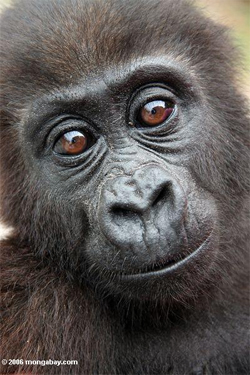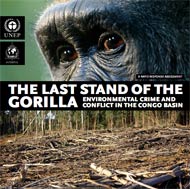Gorillas may disappear across much of the Congo Basin by the mid 2020s unless action is taken to protect against poaching and habitat destruction, warns a new report issued by United Nations and INTERPOL.
The Last Stand of the Gorilla – Environmental Crime and Conflict in the Congo Basin — released at the CITES meeting in Doha, Qatar — lists a multitude of threats to gorillas, including the bushmeat trade, outbreaks of the ebola virus, illegal logging, mining, and charcoal production. The report warns that that militias in eastern Democratic Republic of Congo (DRC) are exacerbating the gorilla crisis through trafficking and involvement in other illicit activities. Gorilla bushmeat moves through the same smuggling channels as illegally extracted timber, diamonds, gold and coltan (a mineral used in cell phones). Further, insecurity in the region has driven hundreds of thousands of people into refugee camps, which has increased pressure on natural resources, including forest habitat for gorillas and the apes themselves.
 Orphaned gorilla near Loango National Park. Photo by Rhett A. Butler |
“With the current and accelerated rate of poaching for bushmeat and habitat loss, the gorillas of the Greater Congo Basin may now disappear from most of their present range within ten to fifteen years,” said UNEP’s Christian Nellemann, lead author of the report, in a statement. “We are observing a decline in wildlife across many parts of the region, and also side-effects on poaching outside the region and on poaching for ivory and rhino horn, often involving poachers and smugglers operating from the Congo Basin, Uganda, Burundi and Rwanda, to buyers in Asia and beyond.”
“This is a tragedy for the great apes and one also for countless other species being impacted by this intensifying and all too often illegal trade,” Achim Steiner, UN Under-Secretary General and Executive Director of the UN Environment Program (UNEP), added in the statement.
“Ultimately it is also a tragedy for the people living in the communities and countries concerned. These natural assets are their assets: ones underpinning lives and livelihoods for millions of people. In short it is environmental crime and theft by the few and the powerful at the expense of the poor and the vulnerable.”
In linking militias to gorillas, UNEP and INTERPOL are seeking increased support for the international police agency’s Environmental Crime Program as well as an expanded role for MONUC, the UN peacekeeping operation in the DRC operating mainly North and South Kivu.
 The Last Stand of the Gorilla |
“Strengthening its mandate in terms of support for park rangers and control of border crossings, in collaboration with national customs and international bodies, could go a long way to reduce the revenue-raising activities of militias and their role in the illegal trade,” stated a press release from UNEP. “This in turn would bring a peace dividend for the people of the region.”
“The gorillas are yet another victim of the contempt shown by organized criminal gangs for national and international laws aimed at defending wildlife,” said David Higgins, Manager of the INTERPOL Environmental Crime Program, in a statement. “The law enforcement response must be internationally co-coordinated, strong and united.”
The Last Stand of the Gorilla – Environmental Crime and Conflict in the Congo Basin